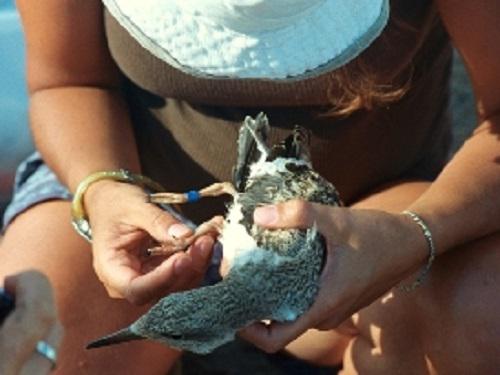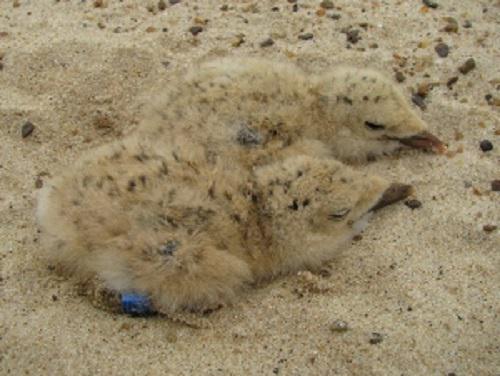Rocio Mariano Jelicich
Through this project we expect to provide novel information about the Black Skimmer on a continental scale, attempting to cover some information gaps regarding to migration, population numbers and conservation status.

Working at breeding sites. © Carlos García Mata.
The South American subspecies of the Black Skimmer (Rynchops niger intercedens) is a Neotropical bird, widely distributed from Venezuela to the Southern-east coast of Argentina. The extant information for this subspecies is scarce and restricted to local areas on their distribution (Zusi 1996). This lack of information gives uncertainties about the subspecies’ conservation status. Moreover, in South America, breeding and non-breeding sites are located next to big rivers or important coastal areas that can be easily disturbed by human activities.

Skimmer chicks.© Germán O. García.
In Argentina, the information on breeding grounds reports small colonies next to big rivers, contrasting with the high numbers (up to 12,000 birds) registered on non-breeding grounds on the southeast coast of Buenos Aires Province (Klimaitis and Moschione 1984, Mariano-Jelicich et al. 2003). The existence of important colonies in Brazil and Venezuela, rises the suggestion of a non-breeding mix of birds proceeding from colonies distributed in other big South American basins apart from Argentinean ones. This gives a potential scenario of a continental migration in skimmers, where estuaries and coastal areas of Argentina could be critical and important sites for the conservation and management of this species. In this context the main goal of this project is to study the migratory patterns of this subspecies through a continental approach, connecting breeding and non-breeding areas in South America.
This information is crucial when it comes to establish and implement comprehensive conservation programs. Moreover, this regional focus is necessary for developing effective measures towards the protection of key sites for migratory species like fluvial and coastal areas.
The following particular objectives had been proposed:
1) to make the first estimation of population numbers of this subspecies;
2) to analyse the migratory chronology of different breeding and non-breeding populations of the Black Skimmer;
3) to study the degree of population structure at non-breeding and breeding grounds of the Black Skimmer and analyse the connectivity patterns between areas.
The study will be conducted at the Laguna Mar Chiquita (Buenos Aires, Argentina), one of the most important non-breeding sites in Argentina, and several breeding areas from South America. The field work is hard including night surveys in coastal areas when studying wintering populations. The laboratory work will involve DNA analysis for the study of genetic variability of the different populations and the study of hydrogen isotopic signatures for the analysis of the connectivity between areas. For this study we count with the collaboration of several colleagues from Argentina, Venezuela and Brazil. During this study we plan to promote the academic interaction of head researchers and training of junior researchers and students on different field and laboratory techniques.